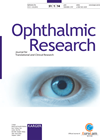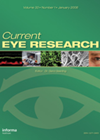You searched for "choroid"
Complement Factor H and Factor H-Like protein are expressed in human RPE cells
1 April 2014
| Bheemanagouda Patil
|
EYE - General
The role of inflammation in age-related macular degeneration (AMD) is well documented and the association of AMD with the inflammatory marker C-reactive protein (CRP) and members of the complement system underline the role of complements in AMD. Human complement factor...
Macular pigment and dark adaptation in older population with normal maculas
1 December 2018
| Kurt Spiteri Cornish
|
EYE - Vitreo-Retinal
Macular pigment (MP) such as lutein, zeaxanthin and meso-zeaxanthin are highly concentrated in the fovea. They protect the retina from damage of ambient blue light via antioxidant properties. In older eyes with normal healthy retina, macular pigment optical density (MPOD)...
Migraine attack: does retinal and peripapillary blood flow change?
7 April 2021
| Claire Howard
|
EYE - Neuro-ophthalmology
This prospective clinical study compared retinal and peripapillary blood flow parameters in migraine patients during an attack with healthy controls using optical coherence tomography angiography (OCTA). OCTAs were performed on 52 eyes from 26 migraine sufferers and 48 eyes from...
Choroidal changes after horizontal strabismus surgery
The aim of this study was to investigate choroidal changes in the short-term by looking at the choroidal vascular layer after horizontal strabismus surgery. This was a retrospective study of 27 patients: 12 females and 15 males with mean age...The management of chronic central serous chorioretinopathy
1 February 2017
| Marten E Brelen
|
EYE - Vitreo-Retinal
Central serous chorioretinopathy (CSCR) is a common retinal disease characterised by one or more serous neurosensory detachments. Patients present with acute onset blurring of vision, metamorphopsia and / or central scotomas. The condition is six times more common in men...
The challenge of chorioretinal folds in virtual eye clinics
3 June 2024
| Noorulain Khalid, Faizan Hashmi, Adam Riaz, Hadi Ziaei, Abha Gupta
|
EYE - Vitreo-Retinal, EYE - Orbit
Chorioretinal or choroidal folds are parallel striations involving the retina, retinal pigment epithelium (RPE), Bruch’s membrane, and inner choroid [1]. They can arise from compressive stress on these layers, and their presence often serves as a diagnostic marker for underlying...
Choroidal and macular thickness in nonarteritic anterior ischaemic optic neuropathy
1 December 2014
| Claire Howard
|
EYE - Neuro-ophthalmology
This study evaluates the choroidal and macular thickness in patients with chronic nonarteritic anterior ischaemic optic neuropathy (NA-AION). Two groups of subjects were compared, group one included 20 eyes with chronic NA-AION and group two, 31 healthy control eyes. The...
The treachery of images – making sense of OCT imaging
In 1929 Belgian surrealist Rene Magritte produced his painting La Trahison des Images. It depicted an old fashioned pipe for smoking tobacco and underneath were the words “ceci n’est pas une pipe”, this is not a pipe. You may wonder...What’s next in retinal imaging? Faster, deeper and full-on
Fast-evolving technological leaps are opening the way toward clinically useful ocular coherence angiography, generating 3-dimensional microvasculature maps without intravenous dye injection, as well as whole-eye imaging, handheld patient-operated optical coherence tomography (OCT) devices and, for challenging vitreoretinal procedures, integrated intraoperative...Neurofibromatosis with multiple bilateral choroidal nevi and literature review
14 November 2024
| Mehru-Nisah Hanif, Syed Raza Ali Zaidi, Nausheen Hayat
|
EYE - Imaging, EYE - Oncology, EYE - Vitreo-Retinal
The aim is to present a case of neurofibromatosis type-1 (NF-1), also known as von Recklinghausen disease, who presented with bilateral multiple choroidal nodular nevi following chemotherapy and mastectomy for breast cancer. Neurofibromatosis type-1 presents as a wide range of...
25 years of OCT
David Huang first described optical coherence tomography (OCT) in 1991, in his seminal paper on the subject in Science. This method developed the work of others on ophthalmic interferometry, which essentially showed that measuring reflected light could be used to...OCT angiography sign after whiplash
7 December 2020
| Annes Ahmeidat
|
EYE - Vitreo-Retinal
Berlin’s oedema is a rare condition following blunt ocular injury and a rare finding after whiplash injury. This case describes a 48-year-old male who suffered a seventh vertebrae fracture from a traffic accident. Two days later, decreased left eye visual...









